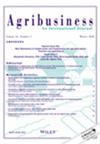新鲜鸡肉和冷冻鸡肉的消费模式:加纳食品政策视角
IF 2
3区 经济学
Q2 AGRICULTURAL ECONOMICS & POLICY
引用次数: 0
摘要
尽管全球家禽消费量增加,但不同国家对鸡肉产品的偏好各不相同。在加纳,有两大类产品在市场上占据主导地位:活鸡/新鲜整鸡和进口冷冻鸡肉部分。本研究利用来自 13201 个家庭的数据,采用二次几乎理想需求系统探讨加纳人对这些产品的需求动态。研究结果显示了这两种产品之间的明显差异。活鸡/新鲜整鸡被视为奢侈品,与其他非鸡肉产品、文化节日和各种社会人口因素之间存在复杂的相互作用。与此同时,被视为必需品的冷冻鸡肉部分则表现出不同的需求转移和消费高峰期。重要的是,这两类鸡肉作为不同的产品出现,表明政策制定者需要采取不同的策略。模拟的政策情景进一步强调,降低活鸡/新鲜鸡价格比提高冷冻部分价格的政策更能显著促进国内鸡肉需求。然而,两种政策类型对替代蛋白质来源的广泛影响是不同的。我们敦促政策制定者在考虑这些细微差别的同时采取综合方法,在不对市场造成意外干扰的情况下加强加纳国内家禽业的发展。[经济文献引用:Q11, Q13, Q17, Q18, D12]。本文章由计算机程序翻译,如有差异,请以英文原文为准。
Consumption patterns of fresh and frozen chicken: A Ghanaian food policy perspective
Despite the global increase in poultry consumption, there are different preferences for chicken products in different countries. In Ghana, two main categories dominate the market: live/fresh whole chickens and imported frozen chicken parts. This study leverages data from 13,201 households to explore Ghanaian demand dynamics for these products using the Quadratic Almost Ideal Demand System. Findings reveal stark differences between the two. Live/fresh whole chickens, considered luxury goods, display a complex interplay with other non‐chicken meat products, cultural festivities, and various sociodemographic factors. Meanwhile, frozen chicken parts, seen as necessities, exhibit different demand shifters and peak consumption periods. Importantly, these two categories emerge as distinct products, signaling to policymakers the need for differentiated strategies. Simulated policy scenarios further emphasize that reducing prices of live/fresh chickens significantly boosts domestic chicken demand more than policies raising prices of frozen parts. However, the broader implications on alternative protein sources differ between the two policy types. We urge policymakers to adopt an integrated approach, considering these nuances, to strengthen Ghana's domestic poultry sector without unintended market disruptions. [EconLit citations: Q11, Q13, Q17, Q18, D12].
求助全文
通过发布文献求助,成功后即可免费获取论文全文。
去求助
来源期刊

Agribusiness
农林科学-食品科技
CiteScore
5.50
自引率
6.20%
发文量
58
审稿时长
6 months
期刊介绍:
Agribusiness: An International Journal publishes research that improves our understanding of how food systems work, how they are evolving, and how public and/or private actions affect the performance of the global agro-industrial complex. The journal focuses on the application of economic analysis to the organization and performance of firms and markets in industrial food systems. Subject matter areas include supply and demand analysis, industrial organization analysis, price and trade analysis, marketing, finance, and public policy analysis. International, cross-country comparative, and within-country studies are welcome. To facilitate research the journal’s Forum section, on an intermittent basis, offers commentary and reports on business policy issues.
 求助内容:
求助内容: 应助结果提醒方式:
应助结果提醒方式:


